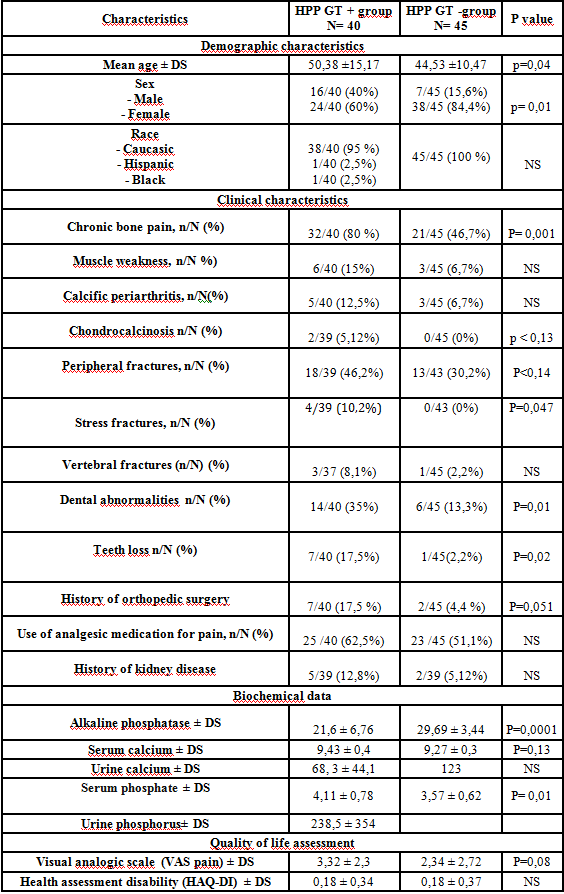Session Information
Date: Monday, November 6, 2017
Title: Osteoporosis and Metabolic Bone Disease – Clinical Aspects and Pathogenesis
Session Type: ACR Concurrent Abstract Session
Session Time: 4:30PM-6:00PM
Background/Purpose: Hypophosphatasia (HPP) is a rare inherited disorder caused by mutations in ALPL (alkaline phosphatase liver type ALPL gene). Clinical presentation is variable and adult forms of the disease are usually milder than those affecting infants and children. It can be easily overlooked or misdiagnosed as chondrocalcinosis or osteoporosis, which can lead to erroneous therapeutic decisions. The primary objectives were to estimate the prevalence of patients with adult forms of HPP, to analyze their clinical and functional characteristics and to compare these findings between the patients with or without mutations. Methods: In this cross-sectional study, 1.536.711 ALP measurements from 386.356 patients were evaluated between 2009 and 2015. Those having at least two values below 35 IU/l and none above 45 IU/l constituted the study population, a total of 427 patients were included. Among them, 31 were excluded because of secondary hypophosphatasemia and 13 were lost on follow-up. 108 patients were contacted by phone to fulfill a questionnaire about clinical manifestations and health assessment. Patients were divided into two groups according to whether or not they presented a positive (HPP GT+) or negative (HPP GT-) genetic test. Results: Demographic and clinical characteristics are shown in Table 1. Of the 108 patients evaluated, genetic results were available for 85: 47% (40/85) were found to have pathogenic mutations, five previously unreported with the remaining having variants of unknown significance. We identified compound heterozygous mutations in an adult patient diagnosed with infantile HPP and the rest were in heterozygosity and associated with a less severe phenotype. Nine patients carried mutations associated with odontohypophosphatasia. A significantly higher proportion of patients in the HPP GT+ group presented bone pain (80 v 46.7%, p=0.001), dental abnormalities (35 v 13.3%, p=0.01), premature dental loss (17.5 v 2.2%, p=0.02), and stress fractures (10.2 v 0%, p=0.047). Furthermore, there was a non-significant trend to present orthopedic surgery, chondrocalcinosis and peripheral fractures in this group. No significant differences were found in muscle weakness, vertebral fractures, calcific periarthritis, renal disease or necessity of analgesic medication. In terms of biochemical tests, an elevation of serum phosphate was found in the HPP GT+ group (4.1± 0.8 v 3.6 ± 0.6, p=0.01). No differences were observed in pain assessment (Visual Analogue Scale-VAS) and the health assessment questionnaire (HAQ-DI). Conclusion: The diagnosis of HPP can be difficult and is often missed or delayed, particularly in adults. The prevalence of HPP in patients with low ALP values is high and although clinical presentation is milder in adults, it often presents with bone pain, dental abnormalities, premature loss and fractures. These data should promote a proactive attitude towards detection of adult HPP.
To cite this abstract in AMA style:
Tornero C, Aguado P, García-Carazo S, Tenorio JA, Lapunzina P, Heath K, Buño A, Iturzaeta JM, Monjo I, Plasencia C, Balsa A. Low Alkaline Phosphatase Levels: Could It be Hypophosphatasia? [abstract]. Arthritis Rheumatol. 2017; 69 (suppl 10). https://acrabstracts.org/abstract/low-alkaline-phosphatase-levels-could-it-be-hypophosphatasia/. Accessed .« Back to 2017 ACR/ARHP Annual Meeting
ACR Meeting Abstracts - https://acrabstracts.org/abstract/low-alkaline-phosphatase-levels-could-it-be-hypophosphatasia/

